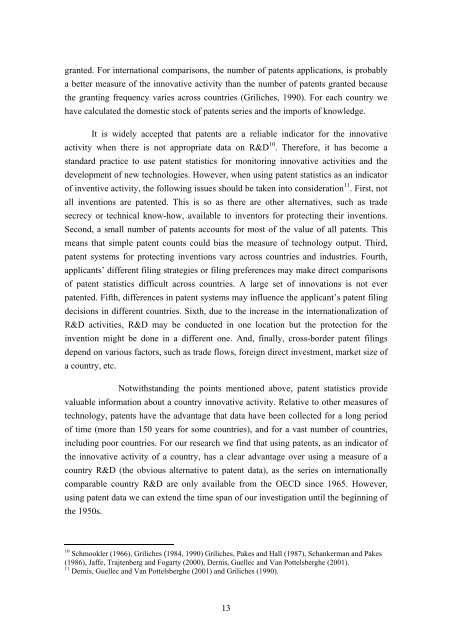You also want an ePaper? Increase the reach of your titles
YUMPU automatically turns print PDFs into web optimized ePapers that Google loves.
granted. For international comparisons, the number of patents applications, is probably<br />
a better measure of the innovative activity than the number of patents granted because<br />
the granting frequency varies across countries (Griliches, 1990). For each country we<br />
have calculated the domestic stock of patents series and the imports of knowledge.<br />
It is widely accepted that patents are a reliable indicator for the innovative<br />
activity when there is not appropriate data on R&D 10 . Therefore, it has become a<br />
standard practice to use patent statistics for monitoring innovative activities and the<br />
development of new technologies. However, when using patent statistics as an indicator<br />
of inventive activity, the following issues should be taken into consideration 11 . First, not<br />
all inventions are patented. This is so as there are other alternatives, such as trade<br />
secrecy or technical know-how, available to inventors for protecting their inventions.<br />
Second, a small number of patents accounts for most of the value of all patents. This<br />
means that simple patent counts could bias the measure of technology output. Third,<br />
patent systems for protecting inventions vary across countries and industries. Fourth,<br />
applicants’ different filing strategies or filing preferences may make direct comparisons<br />
of patent statistics difficult across countries. A large set of innovations is not ever<br />
patented. Fifth, differences in patent systems may influence the applicant’s patent filing<br />
decisions in different countries. Sixth, due to the increase in the internationalization of<br />
R&D activities, R&D may be conducted in one location but the protection for the<br />
invention might be done in a different one. And, finally, cross-border patent filings<br />
depend on various factors, such as trade flows, foreign direct investment, market size of<br />
a country, etc.<br />
Notwithstanding the points mentioned above, patent statistics provide<br />
valuable information about a country innovative activity. Relative to other measures of<br />
technology, patents have the advantage that data have been collected for a long period<br />
of time (more than 150 years for some countries), and for a vast number of countries,<br />
including poor countries. For our research we find that using patents, as an indicator of<br />
the innovative activity of a country, has a clear advantage over using a measure of a<br />
country R&D (the obvious alternative to patent data), as the series on internationally<br />
comparable country R&D are only available from the OECD since 1965. However,<br />
using patent data we can extend the time span of our investigation until the beginning of<br />
the 1950s.<br />
10 Schmookler (1966), Griliches (1984, 1990) Griliches, Pakes and Hall (1987), Schankerman and Pakes<br />
(1986), Jaffe, Trajtenberg and Fogarty (2000), Dernis, Guellec and Van Pottelsberghe (2001).<br />
11 Dernis, Guellec and Van Pottelsberghe (2001) and Griliches (1990).<br />
13

















